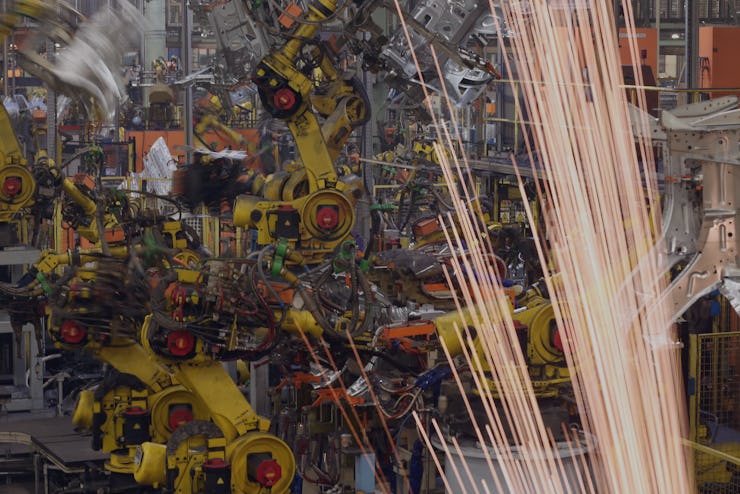Manufacturing Goes Where the Robots Are
Automation expert John Crews says robo-sourcing is about to make the idea of outsourcing obsolete.

In the eight months since engineer John Crews’s book on the robot future hit shelves, the global political climate has changed so drastically that Robonomics now reads like an outsider political treatise. The survey of the fourth industrial revolution explores a heavily automated future in which governments supply citizens with basic income and concerns about job loss are couched in broader conversations about ending scarcity and the socio-economic problems it presents. It’s a coherent vision of progress, but one that does jibe with the results of the U.S. presidential election or the Brexit vote, both of which galvanized a group of voters demanding their old jobs back.
For Crews, who knows what the machines are capable of doing and at what cost, European and American pushback looks a little like railing against gravity. Given that the same people who want jobs that robots will take also seem to want to live in free-market societies, there is little reason to believe that public policy is going to result in long-term employment in traditional manufacturing roles. Still, political promises may be honored even as corporations divest from human expertise, creating a chaotic environment and potentially leading to even further divisiveness.
Inverse caught up with Crews to talk about what happens next and why mass unemployment might actually be a worthy goal for the developed world.
Earlier this month, Donald Trump was elected president of the United States. One of his aims is to bring manufacturing jobs back to the country. How does this fit with the automation future?
Manufacturing is returning to the United States, but not manufacturing jobs. Companies moved their manufacturing to places with very cheap labor. The advanced automation revolution will make labor costs irrelevant, by making them nearly zero. The factory of the near future will be located in an optimum location to take advantage of its proximity to raw materials, markets, and cheap energy — the labor cost will not be a factor when almost all the work is robo-sourced; that is, done by A.I. algorithms and robots.
Politicians will take the credit for bringing manufacturing back, but in fact few new jobs will be created. Most voters and politicians are simply not aware of the impact advanced automation will have on our economy and society. It is less and less outsourcing they should be concerned with; more and more it will be robo-sourcing that will take and keep jobs from humans.
This backlash is being felt elsewhere. Industrial decline has contributed to a rise in populist movements across Europe. Will the people really accept robot automation if it makes things worse?
Advanced automation will make things worse in the sense that jobs will be harder and harder to come by. But it will also make things better by providing goods and services at lower and lower prices. If people try to reject A.I. robots, such as by implementing laws that limit their use or levying high taxes on robots, manufacturing will simply move to countries that are robot-friendly.
A robot waiter delivers meals for customers at robot-themed restaurant in China.
What is the ‘Great Deflation’? By the name I’m guessing it’s not a good thing.
Automation ultimately means that the costs of goods and services will fall. This happened in the 1870s when the cost of high-quality steel fell sharply due to advanced manufacturing methods. This led to dramatic price decreases. Prices fell about one-third for all items, and the prices of some agricultural goods, notably cotton and wheat, fell by 80 percent. The period came to be known as the ‘Great Sag or the “Great Deflation.’
We will have a second ‘Great Deflation’ when automation completely removes the cost of labor from manufacturing and services. Prices on many items will fall 50 percent to 75 percent or more, greatly lowering the cost of living for everyone. On the other side of that coin, the things you own will be worth less; the values of your house, your car, your investments will also fall dramatically.
Scotland is set to join Finland and the Netherlands in trialing a universal basic income. Will we need a basic income in the robot future?
We will eventually reach a point where (almost) no one will be able to trade their labor for money. No matter how low prices go, a person with no income is not able to buy anything. A universal basic income will be the fairest way to provide for the people. It’s important to note that a UBI will replace almost all entitlement programs — welfare, Medicare, Medicaid, SNAP (food stamps), etc. Most people will have to make a UBI stipend pay for all their expenses - housing, food, health care, entertainment, etc. Fortunately, A.I. systems will help guide their expenditures and prevent their money from being squandered.
What’s the biggest immediate automation threat we’re going to need to handle?
Advanced automation will lead inevitably to mass unemployment. The U.S. government gets about 70 percent of its income from taxes on labor, and that revenue will be lost at a time when a UBI will need to be implemented. In my book, I go into detail on how the government can raise revenue to provide for a UBI when monies from income tax and payroll taxes fall to nearly zero.
What about for the long term?
The road to the future will be very rough. However, the implications of free labor for everyone are astounding. Automation will free us from drudgery, danger, and want, and allow us to live the lives we wish. As Arthur C. Clarke said, ‘The goal of the future is full unemployment, so we can play.’ Call me an optimist, but I think the future world, while not perfect, will be a much safer, healthier, happier place.